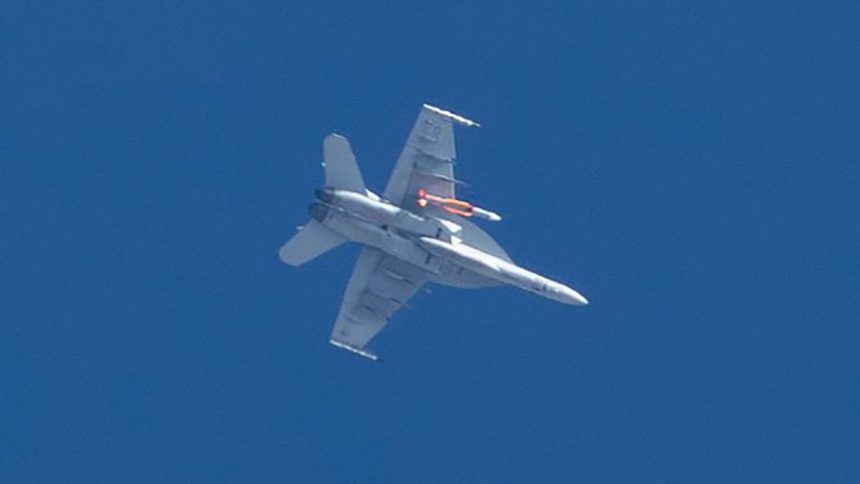Originally developed as a surface-to-air missile, the Standard Missile 6 has been now installed, once again, on a Super Hornet. The reasons remain unknown so far.
A US Navy F/A-18 Super Hornet was spotted with a rather uncommon payload under its wings, an inert Standard Missile 6 (SM-6) surface-to-air missile. The weapon, also known as the RIM-174 Standard Extended Range Active Missile (ERAM), has been designed to be used on Navy ships in conjunction with the Aegis Combat System.
The photos which you can see in this article were shared with us by photographer @StinkJet, who spotted the aircraft about 60 miles north of Naval Air Weapons Station China Lake on Apr. 17, 2024. Based on the radio communications which he heard shortly before sighting the aircraft overheard, StinkJet says the Super Hornet might belong to Air Test and Evaluation Squadron (VX) 9.
Vampire Rhino with what looks like an AGM-84H/K SLAM-ER painted in the orange test paint. Maybe someone else can give a better ID of what it is? pic.twitter.com/kIMiWFXcBo
— StinkJet (@StinkJet) June 3, 2024
“I was shooting other aircraft in the R-2508 and heard some activity from VX-9 on the radio,” @StinkJet told us. “10 or 15 minutes later we heard the jet overhead and I took a couple shots because we don’t usually see aircraft with orange test armament. I also thought the missile looked much larger than standard stuff we are used to seeing so I kept the shots”.
Although the photos don’t allow to visually identify the aircraft insignias, StinkJet says he’s fairly confident that the F/A-18 is assigned to VX-9 because of the earlier radio communications. He also added that the jet did three orbits while overhead before leaving the area.
That’s an SM-6; normally featuring a booster for launch from a Naval Mk.41 vertical launch system. Would potentially allow hugely longer range engagements than possible with AMRAAM, possibly targeted by either F/A-18E/F, or E-2D or Aegis ships via NIFC-CA… serious capability https://t.co/HMLVjK5SC0 pic.twitter .com/wuwx7vjoWu
— Justin Bronk (@Justin_Br0nk) June 3, 2024
This is actually not the first time an SM-6 missile is spotted installed on a Super Hornet .
In 2021, an F/A-18F assigned to VX-31 was photographed with the same missile under its wings. Similarly to this April’s sighting, the missile had its first stage booster removed.
As soon as the photos circulated online , discussion started about a possible integration of the weapon as a long-range air-to-air or anti-surface missile on the Super Hornet. The US Navy, however, has never acknowledged similar plans, so that possibility was to be considered as pure speculation.
The Standard Missile 6
The RIM-174 Standard Extended Range Active Missile (ERAM), or Standard Missile 6 (SM-6), is one of the weapons employed for the air defense of the US Navy ships. Integrated in the Aegis Combat System, the weapon was designed for extended-range anti-air warfare, but it can also be employed for terminal phase ballistic missile defense and as anti-ship missile .
The missile uses the airframe of the SM-2ER Block IV (RIM-156A) missile, with the addition of an active radar homing seeker derived from the one of the AIM-120 AMRAAM air-to-air missile . The Mach 3.5 weapon has a published range of 130 nautical miles.
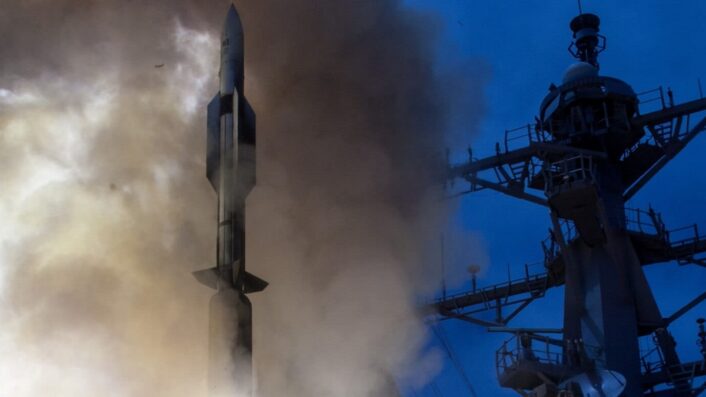
The SM-6, also designated Standard Extended Range Active Missile, greatly expands the AEGIS Weapon System battlespace . SM-6 provides not only an extended range anti-air warfare capability, but also an anti-surface warfare capability to be expressed against enemy ships.
The weapon has been officially employed in combat for the first time earlier this year, when the Department of Defense acknowledged that the USS Carney used the SM-6 to shoot down an anti-ship ballistic missile in the Gulf of Aden fired by Houthi rebels on Jan. 30.
Integrating a long-range anti-shipe missile
As said, among the various options, there is also the possibility that testing of a new air-to-surface missile for the Super Hornet is underway for quite some time.
While Super Hornets can employ the Harpoon missiles for such missions, the SM-6 offers a substantial improvement. With a range potentially exceeding three times that of the Harpoon, it presents a formidable challenge for adversaries to defend against. Combining SM-6s with anti-ship cruise missiles creates a layered defense that significantly complicates the protection of targeted vessels or fleets, thus increasing the likelihood of successfully neutralizing them. Moreover, the ability of aircraft to launch from less predictable angles compared to traditional warships further amplifies the difficulty of defending against such attacks.
Generally speaking, integrating a long-range anti-ship missile onto an aerial platform like the F/A-18E Super Hornet holds significant strategic importance for several reasons:
Enhanced Maritime Strike Capability: The F/A-18E Super Hornet is primarily a multirole fighter aircraft, capable of both air-to-air and air-to-ground missions. By integrating a long-range missile, it gains a potent anti-ship capability, significantly enhancing its maritime strike capabilities. This allows the aircraft to engage surface targets, including enemy ships, from standoff distances, reducing its vulnerability to enemy air defenses and increasing its lethality in naval warfare scenarios.
Extended reach: The SM-6 missile is designed with a long-range capability, allowing it to engage targets at extended distances, typically beyond the reach of traditional anti-ship missiles. By integrating such a weapon onto the F/A-18E Super Hornet, it extends the aircraft’s operational reach, enabling it to strike targets further out at sea, thereby expanding the area of influence and enhancing its effectiveness in controlling maritime spaces.
Flexibility and Versatility: The integration of the SM-6 missile onto the Super Hornet provides greater flexibility and versatility in mission planning and execution. The aircraft could switch seamlessly between various mission profiles, including air superiority, close air support, and maritime strike, based on evolving tactical situations and strategic objectives. This versatility enhances the overall effectiveness and adaptability of the platform in dynamic operational environments.
Force Multiplier : The combination of a capable aerial platform like the F/A-18E Super Hornet with a long-range anti-ship missile could serve as a force multiplier for naval forces. It would enhance the effectiveness of carrier strike groups and expeditionary forces by providing them with an additional layer of offensive capability against surface threats, thereby increasing their survivability and combat effectiveness in contested maritime environments. It would also have a deterrence value as it would send a clear message to potential adversaries about the ability and willingness of naval forces to project power and protect maritime interests.
As said, the current anti-ship missile carried by the Super Hornet is the Harpoon.
The A/U/RGM-84 Harpoon is a versatile and reliable anti-ship missile system, designed to be launched from various platforms including ships, submarines, shore batteries, and aircraft. Originally introduced in 1977, it has undergone significant upgrades, including the development of the Harpoon Block II variant in 1998.
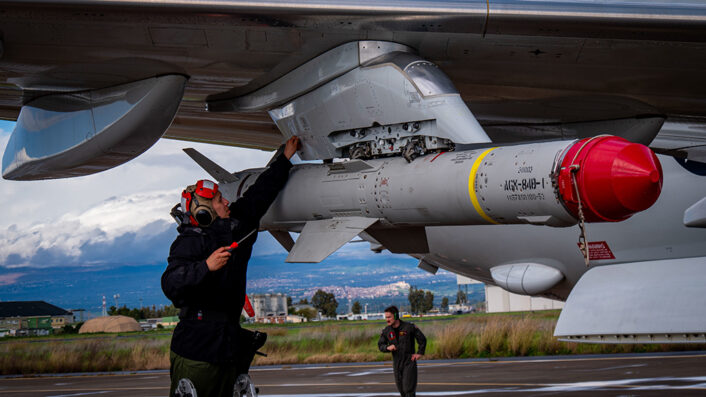
This version integrates GPS-assisted inertial navigation, expanding its capabilities to include both anti-ship and land attack missions. While the Block II variant was not adopted by the US Navy, it has found use among foreign military partners, particularly on F-16 and F-15 aircraft.
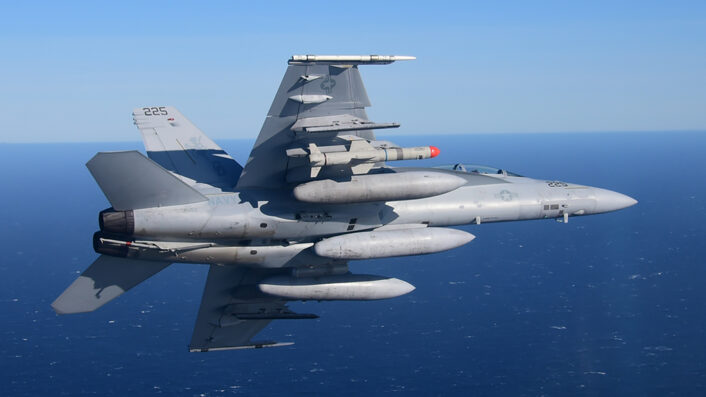
The latest iteration, the Harpoon Block II+, represents a rapid capability improvement for the Navy, featuring improvements in GPS guidance, reliability, survivability, data link interface, target selectivity, abort options, and resistance to electronic countermeasures. This updated version ensures that the Harpoon missile system remains a potent and adaptable weapon in modern naval warfare scenarios.
Long range air-to-air missile
As explained, someone believes the SM-6 seen in the recent photo might be a long-range AAM (Air-to-Air Missile).
The AIM-54 Phoenix, which was a long-range air-to-air missile used primarily by the U.S. Navy’s F-14 Tomcat fighter aircraft, was retired from service in 2004 with the retirement of the F-14 itself. The AIM-54 was a large missile with an impressive range and multiple-target engagement capability.
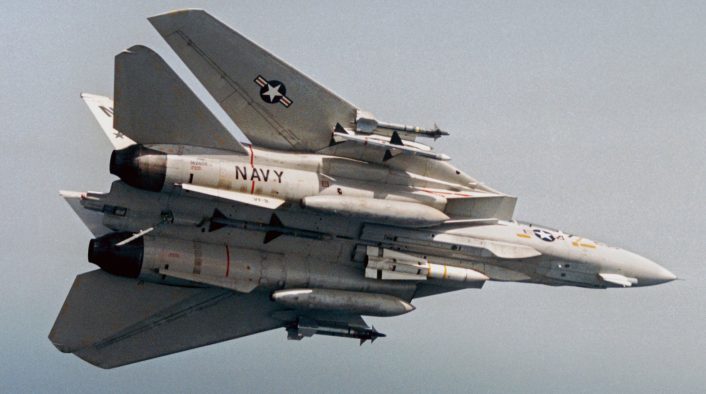
There isn’t a direct replacement for the AIM-54 Phoenix in terms and the F/A-18E/F Super Hornet and the F-35C Lightning II, use different air-to-air missiles.
However, the U.S. military has been working on developing advanced air-to-air missiles to enhance the capabilities of its fighter aircraft. The AIM-260 Joint Advanced Tactical Missile (JATM) is one such development intended to replace the AIM-120 AMRAAM (which is a medium range AAM). While not directly replacing the AIM-54 Phoenix, the AIM-260 aims to provide improved range and performance compared to the AIM-120, which could partially fill the capability gap left by the retirement of the AIM-54.
Thanks again to @StinkJet for allowing us to use the photos and make sure to follow him on Instagram or X for more!

